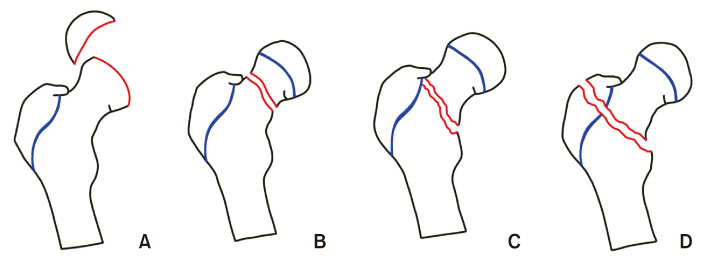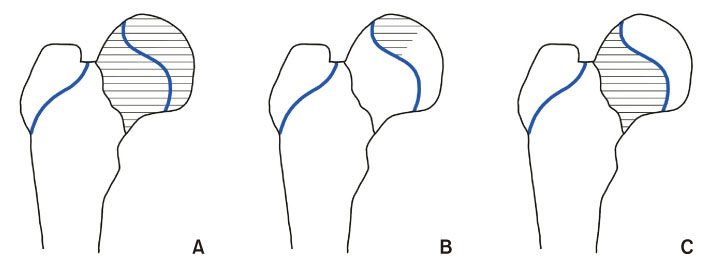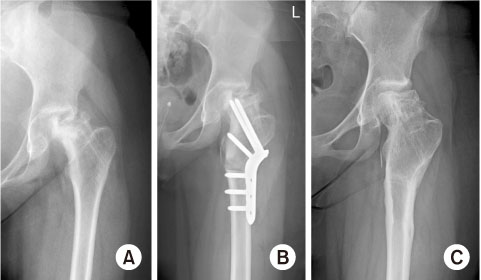Articles
- Page Path
- HOME > J Musculoskelet Trauma > Volume 34(1); 2021 > Article
- Review Article Pediatric Femoral Neck Fracture
- Joo Hyung Han, Hoon Park
-
Journal of Musculoskeletal Trauma 2021;34(1):34-43.
DOI: https://doi.org/10.12671/jkfs.2021.34.1.34
Published online: January 31, 2021
- 850 Views
- 18 Download
- 0 Crossref
- 0 Scopus
Abstract
Pediatric femoral neck fracture is an uncommon injury with a high complication rate, regardless of the appropriate diagnosis and management. The bony anatomy and blood supply of the proximal femur in a skeletally immature patient differ from those in adult patients. Generally, these fractures result from high-energy trauma, but pathologic hip fractures also occur, usually from low-energy trauma. Pediatric femoral neck fractures are categorized using the Delbet classification system. This classification guides management and aids clinicians in determining the risk of avascular osteonecrosis. The ideal surgical treatment is determined by the fracture type and the age of the patient. Reduction, which is achieved using a closed or open procedure, combined with stable fixation and/or cast immobilization, is recommended for most of these fractures. Anatomical reduction within 24 hours from the injury may result in a good surgical outcome. Although the effects of capsular decompression after reduction and fixation have not been established, decompression is easy to perform and may reduce the risk of avascular necrosis. Despite appropriate management, osteonecrosis can occur after all types of pediatric femur neck fractures. Other complications include coxa vara, nonunion, and premature physeal arrest.
Published online Jan 25, 2021.
https://doi.org/10.12671/jkfs.2021.34.1.34
Pediatric Femoral Neck Fracture
 , M.D.
and Hoon Park
, M.D.
and Hoon Park , M.D., Ph.D.
, M.D., Ph.D.
Abstract
Pediatric femoral neck fracture is an uncommon injury with a high complication rate, regardless of the appropriate diagnosis and management. The bony anatomy and blood supply of the proximal femur in a skeletally immature patient differ from those in adult patients. Generally, these fractures result from high-energy trauma, but pathologic hip fractures also occur, usually from low-energy trauma. Pediatric femoral neck fractures are categorized using the Delbet classification system. This classification guides management and aids clinicians in determining the risk of avascular osteonecrosis. The ideal surgical treatment is determined by the fracture type and the age of the patient. Reduction, which is achieved using a closed or open procedure, combined with stable fixation and/or cast immobilization, is recommended for most of these fractures. Anatomical reduction within 24 hours from the injury may result in a good surgical outcome. Although the effects of capsular decompression after reduction and fixation have not been established, decompression is easy to perform and may reduce the risk of avascular necrosis. Despite appropriate management, osteonecrosis can occur after all types of pediatric femur neck fractures. Other complications include coxa vara, nonunion, and premature physeal arrest.
Fig. 1
Delbet classification of pediatric femur neck fractures. (A) Type I, transepiphyseal fracture. (B) Type II, transcervical fracture. (C) Type III, cervicotrochanteric fracture. (D) Type IV, intertrochanteric fracture.
Fig. 2
(A) Anteroposterior radiograph of the 12-year-old boy who sustained a Delbet II femoral neck fracture. (B) Axial radiograph. (C) Radiograph after closed reduction and internal fixation with three cannulated screws inserted through physis. (D) Radiograph at one year after surgery showing union without complication.
Fig. 3
Ratliff classification of avascular necrosis after femur neck fracture. (A) Type I, involvement of the whole head. (B) Type II, partial involvement of head. (C) Type III, area of necrosis in the femoral neck from fracture line to physis.
Fig. 4
(A) Anteroposterior radiograph of the 11-year-old girl who developed avascular necrosis after a femur neck fracture. (B) Vagus osteotomy and internal fixation with plate were performed. (C) Five years postoperative radiographs that demonstrate partial remodeling of the femoral head.
Financial support:None.
Conflict of interests:None.
References
-
Edgren W. Coxa plana. A clinical and radiological investigation with particular reference to the importance of the metaphyseal changes for the final shape of the proximal part of the femur. Acta Orthop Scand Suppl 1965;Suppl 84:1–129.
-

 E-submission
E-submission KOTA
KOTA TOTA
TOTA TOTS
TOTS





 Cite
Cite

